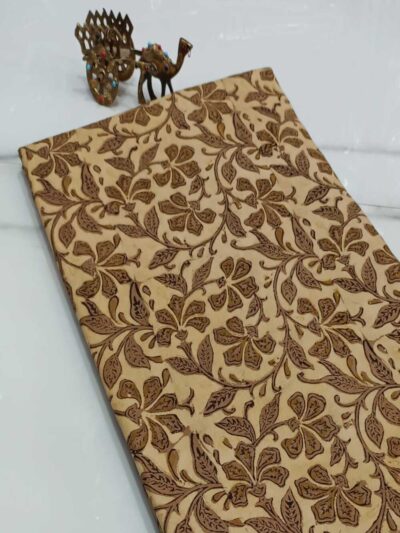Description
Hand block printed cotton dabu fabric In Jaipur
Hand block printed cotton dabu fabric In Jaipur is a testament to the rich textile heritage of India, blending ancient craftsmanship with contemporary fashion sensibilities. This traditional fabric, known for its intricate designs and vibrant hues, is a favorite among fashion enthusiasts and designers alike. Let’s delve into the world of Dabu printing, exploring its history, the intricate process involved, and its enduring appeal in modern times.
A Glimpse into History
The origins of Dabu printing can be traced back to Rajasthan, India, where this art form flourished centuries ago. The word “Dabu” itself is derived from the Hindi word meaning “to press.” Historically, Dabu printing was patronized by royal families, and its techniques were closely guarded secrets passed down through generations of artisans.
The Intricate Process of Dabu Printing
Creating Dabu fabric is a labor-intensive process that involves multiple stages, each requiring a high level of skill and precision. Here’s a step-by-step overview of how this exquisite fabric is made:
- Preparing the Fabric: The journey begins with sourcing high-quality cotton fabric, which is then washed to remove any impurities. This ensures that the fabric is ready to absorb the dyes evenly.
- Design Creation: Artisans carve intricate designs onto wooden blocks. Each block corresponds to a different color or pattern. These blocks are often family heirlooms, handed down through generations.
- Applying the Dabu Paste: A unique aspect of Dabu printing is the application of a resist paste made from a mixture of mud, gum, and natural ingredients like wheat chaff. The paste is meticulously applied to the fabric using the carved wooden blocks.
- Sprinkling Sawdust: Once the paste is applied, sawdust is sprinkled over the fabric to protect the resist areas from cracking or smudging during the dyeing process.
- Dyeing the Fabric: The fabric is then dyed, usually with natural dyes. The resist areas, covered with the Dabu paste, remain untouched by the dye, creating a beautiful contrast.
- Washing and Finishing: After dyeing, the fabric is thoroughly washed to remove the resist paste and reveal the intricate patterns. The final product is sun-dried, giving it a natural finish.
The Allure of Hand block printed cotton dabu fabric In Jaipur
What sets Hand block printed cotton dabu fabric In Jaipur apart is its unique charm and the human touch evident in every piece. No two pieces are exactly alike, making each creation one-of-a-kind. The use of natural dyes not only adds to its aesthetic appeal but also makes it eco-friendly.
Versatility in Fashion: Dabu fabric is incredibly versatile, used in a wide range of apparel and accessories. From sarees and salwar kameez to modern dresses and home furnishings, Dabu prints add a touch of elegance and tradition to any outfit or decor.
Comfort and Durability: Cotton, being a natural fiber, offers comfort and breathability, making Dabu fabric ideal for both casual and formal wear. The intricate printing process ensures that the colors and patterns are long-lasting, even with regular use.
Conclusion
Hand block printed cotton dabu fabric In Jaipur is more than just a textile; it is a piece of history, a work of art, and a symbol of sustainable craftsmanship. Its intricate designs and vibrant colors continue to captivate fashion enthusiasts around the world. As we embrace modernity, the timeless beauty of Dabu fabric reminds us of the rich cultural heritage and the skilled artisans who bring these exquisite creations to life.






Reviews
There are no reviews yet.